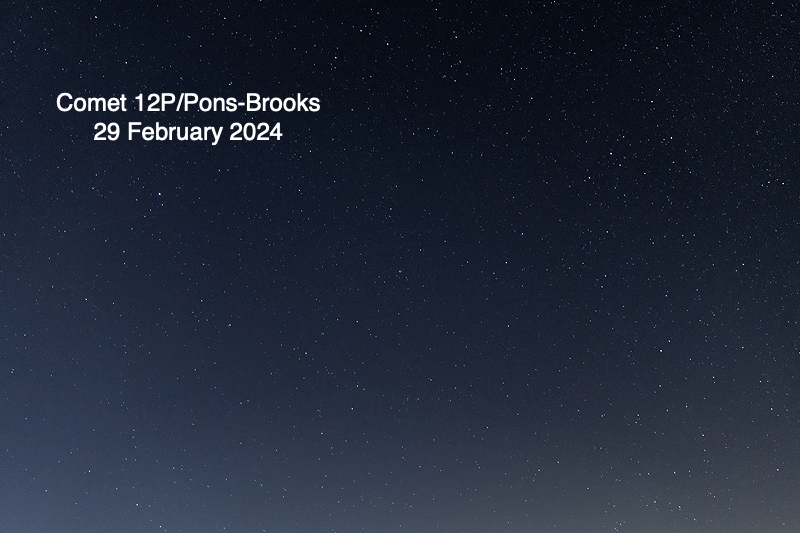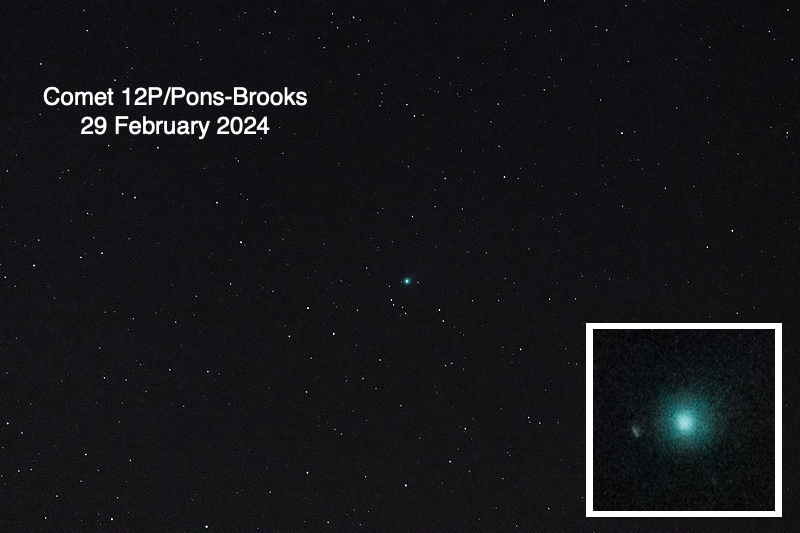iPhone Sun imaging tests, Comet 12P, Occulting Bar tests
Posted: 1 March 2024
Clouds returned to Cassiopeia Observatory's sky on Saturday, 24 February 2024. Monday morning, 26 February, there was some light rain, two days EARLIER than had been forecast! With more days of rain in the forecasts, I went to the observatory to put the Dome Cover ON, but it started raining again, so I decided to wait since the dome was wet. Monday afternoon I put the Dome Cover ON. Three hours later there were four brief periods of 1/4-1/2" hail and even several booms of thunder.
Click to view video
Precipitation total for Monday was minimal however (0.04"). Wednesday afternoon, 28 February, there were several thundershowers (total rain 0.6").
The sky cleared Thursday morning, 29 February. I took advantage of the clear sky to do some quick tests of the free iPhone app Solar Snap in preparation for the Total Solar Eclipse on 8 April 2024. As I completed my tests, some clouds began appearing, becoming partly cloudy for most of the afternoon. In the afternoon I visited a local amateur astronomer who wanted my advice on site planning for his observatory. Late afternoon the sky began to clear.
|
Open: Thursday, 29 February 2024, 1806 MST Temperature: 69°F |
Session: 1943 Conditions: Mostly clear |
Equipment:
12" f/8 LX600 w/StarLock
2" 24mm UWA eyepiece
12x50 binoculars
1.25" 26mm Occulting Bar eyepiece
2" 4X Powermate
Camera:
D850 DSLR
iPhone 15 Pro Max
1817 MST: Dome Cover OFF.
1819 MST: Sunset.
1820 MST: LX600 ON, StarLock OFF, High Precision OFF.
1823 MST: Viewed Jupiter, 102X. Three moons were visible in the bright twilight sky.
1831 MST: Slewed to Comet 12P/Pons-Brooks, low in the northwestern sky. It was not yet visible in the twilight sky. The comet will appear higher in the sky each night, leading up to possibly being naked eye visible (or not) during the Total Solar Eclipse on 8 April 2024 when it will be close to Jupiter in the sky.
1900 MST: Comet Pons-Brooks was faintly visible in the still bright twilight sky, 102X.
1909 MST: The comet was visible in 12x50 binoculars. No tail was visible. I then moved to higher ground to do sky photography showing the comet.
I mounted the D850 DSLR with 70-300mm focal length lens on a camera tripod (non-tracking mount). I captured these unguided images of Comet 12P/Pons-Brooks. The images are slightly cropped from full-frame.
f/4.5, 10 seconds, ISO 1600, WB 3850K, FL 70mm

Mouseover or tap on image for pointer
f/5.6, 2 seconds, ISO 6400, WB 3850K, FL 70mm

The inset above shows a magnified view of the comet from the same image.
1943 MST: Back at the 12" telescope in the observatory. Viewed the comet, 102X. The green coma was nicely visible, but no tail was seen.
I then resumed my Barnard Objects (dark nebulae) Project. I viewed (or attempted to view) the following, 102X: B202, B203, B204, B205, and B206. I was never quite sure that I saw any of them.
2002 MST: I then did some more Occulting Bar tests using Sirius B. Did I see the "Pup Star"? I will post my Occulting Bar article soon.
2032 MST: LX600 OFF.
2043 MST: Took a Sky Quality reading using a Unihedron SQM-L.
|
Close: Thursday, 29 February 2024, 2046 MST Temperature: 50°F |
Session Length: 2h 40m Conditions: Clear, SQM 20.85 |
Comments are welcome using Email. Please read the Email Etiquette guidance.
Cassiopeia Observatory Home Page
Copyright ©2024 Michael L. Weasner / mweasner@mac.com.
URL = http://www.weasner.com/co/Reports/2024/03/01/index.html
